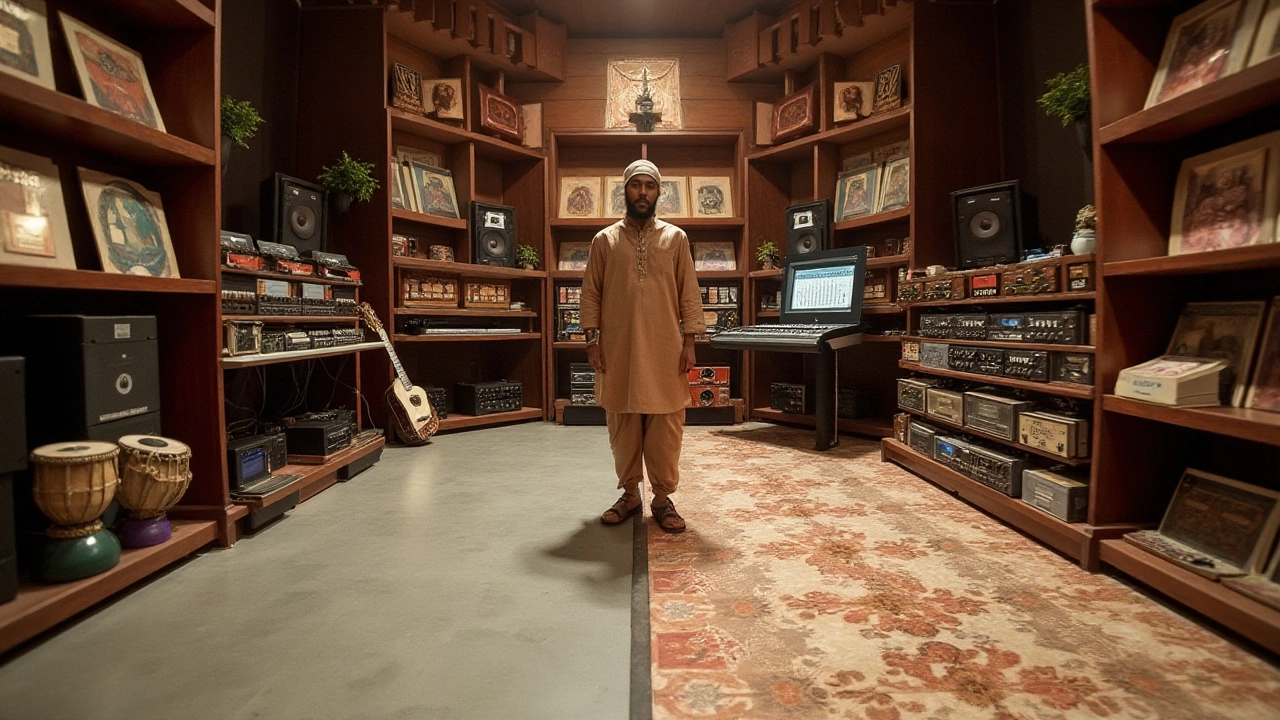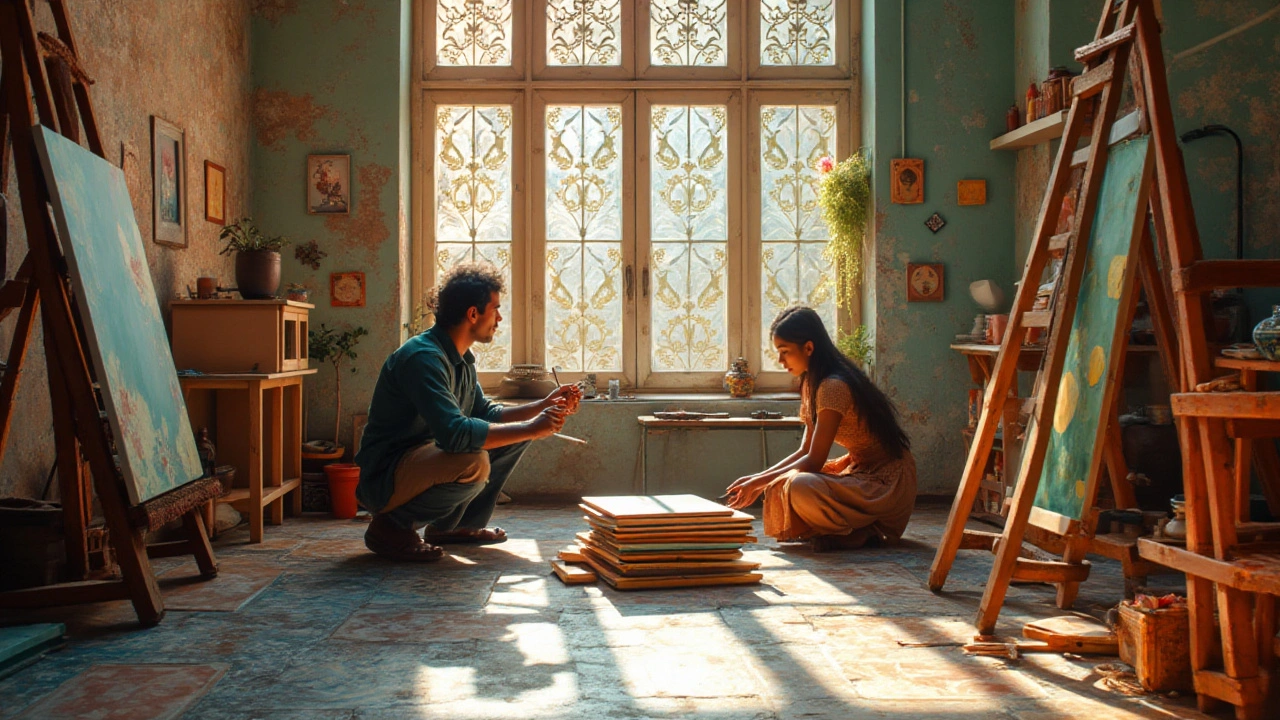When planning a studio setup in India, choosing between slabs and concrete is a decision that requires careful thought. Both materials have distinct characteristics and costs, which can significantly impact the budget and functionality of your space.
Slabs are often perceived as a more cost-effective solution, but this isn't always the case. Various factors come into play, including the intended use of the studio, location, and the specific requirements of the project. Holistically comparing these aspects can lead to an informed decision that aligns with your creative vision.
- Understanding Slabs and Concrete
- Cost Comparison
- Durability and Maintenance
- Installation Process
- Suitability for Studio Environments
- Making the Right Choice
Understanding Slabs and Concrete
When embarking on a project like a studio setup in India, gaining a clear understanding of the building materials is crucial. Slabs and concrete are fundamental to construction, serving as the backbone of many structures. The term 'slab' often refers to a flat, horizontal surface made from reinforced concrete, known for its strength and durability. These are widely used in building floors and ceilings, offering a stable platform. Unlike masonry blocks or bricks, concrete slabs are poured all at once, creating a seamless, uniform surface that can support heavy loads without cracking under pressure.
Concrete itself is an age-old material composed of cement, water, aggregates, and sometimes admixtures that enhance its properties. Its versatility makes it a popular choice for both commercial and residential applications. Historically, the use of concrete dates back to ancient Rome, where structures like the Pantheon showcased its durability—a testament to its lasting appeal in construction. When used in slabs, the benefits are several— thermal comfort, sound insulation, and resistance to extreme weather conditions make concrete slabs an appealing choice. On the other hand, slabs may sometimes refer to precast elements, designed and cured off-site before being transported and installed on-site, reducing the time required for on-site labor.
Concrete, renowned for its adaptability, is a preferred choice for studio setup environments due to its ability to mold into any shape and take on a variety of textures and finishes. This flexibility is key when designing custom spaces tailored for artistic purposes, where the ambiance can significantly affect the creative process. A crucial aspect to consider is the reinforcement; often, steel bars are embedded within the slabs to increase tensile strength, accommodating the dynamic loads exerted by studio equipment and activities.
Overall, the choice between slabs and concrete hinges on specific project requirements and artistic ambitions. In some cases, combining the two offers the best of both worlds: the permanence of concrete with the swift installation process of slabs. Understanding these materials involves not just knowing their composition but evaluating their interactions with factors like local climate, budget constraints, and the intended use of the space. This comprehensive view can help guide decisions and ensure that your studio is not just a creative haven but also a sound investment that stands the test of time.
Cost Comparison
Setting up a studio setup involves a variety of considerations, and cost is often at the forefront of these decisions. When evaluating the expenses related to slabs versus concrete, several factors must be taken into account to determine which option suits your budget and requirements best. Typically, slabs are seen as a less expensive alternative initially, mainly due to their simpler installation process and reduced material expenses. Concrete, known for its durability and robustness, might come across as the pricier variant right off the bat. However, the real cost extends beyond just the price of materials, encompassing aspects like labor, long-term maintenance, and the intended longevity of the studio space.
One of the principal reasons slabs might appear cheaper is because they can often be precast and installed swiftly, minimizing labor fees. Companies in India can deliver slab materials that require minimal on-site handling, allowing swift completion of studio setups. But it's important to consider that choosing slabs may involve additional costs related to reinforcement if the studio requires a heavier load-bearing capacity or enhanced insulation. Concrete, despite its seemingly heftier initial cost, presents a lower maintenance option due to its strength and resilience against natural wear and tear. In regions with fluctuating climates, concrete's thermal properties can potentially lead to savings on energy consumption over time, which may offset the opening expenditure.
To draw a clearer picture, let's delve into some numbers through a practical example. Suppose the cost of installing a basic slab is around ₹200 to ₹300 per square foot, depending on the labor and material availability in the local area. Contrastingly, the cost for concrete installation might start around ₹300 to ₹450 per square foot. The difference here initially seems substantial; however, concrete's longer lifespan often means fewer repairs and replacements, balancing further expenses. It's crucial to note a statement from a well-known construction material expert:
"While slabs offer affordability in the short term, concrete brings long-term peace of mind by ensuring your foundations remain intact without frequent mending."
In conclusion, each material brings its own advantages in terms of cost-effectiveness depending on your project's scope and vision. Understanding these subtleties can aid in choosing the right material for your studio. If you require a short-term setup or have budget constraints, slabs might be preferable. On the other hand, if you're aiming for durability and a stable long-term investment, concrete stands out as a prudent choice. Keep these factors in mind as you embark on your creative journey in a studio setup in India. Your decision today will shape the way your work environment supports you tomorrow.

Durability and Maintenance
When it comes to studio setups in India, the durability and maintenance of construction materials are substantial considerations. Both slabs and concrete offer unique advantages and potential drawbacks in these areas. Traditional concrete is renowned for its exceptional strength and resilience. It is often used in situations requiring a long-lasting and reliable material due to its ability to withstand environmental pressures. Concrete structures can last for decades when maintained properly, but they do require periodic maintenance to preserve their condition.
On the other hand, slabs, which are generally made from prefabricated concrete or alternative materials, can provide versatility and efficiency. This aspect is particularly advantageous in urban environments where studio space comes at a premium and expedited construction might be necessary. Slabs tend to require less intensive maintenance compared to basic concrete structures. Depending on the materials used, they can be lighter and easier to adjust or replace. However, their longevity may not always match that of traditional poured concrete, especially under heavy or sustained load conditions.
According to engineering expert Dr. Ramesh Kapoor, "Choosing between slabs and concrete depends significantly on the intended use and environmental conditions. Prioritizing maintenance can effectively extend the life of any material."Routine care involves inspecting for cracks, sealing surfaces as necessary, and managing moisture exposure, which can erode structural integrity over time. Both slabs and concrete can be susceptible to these issues, though the manifestation and frequency of such problems might vary. Yet, in a comparative light, slabs are often praised for their quick repair capabilities and flexibility in usage, balancing between immediate cost and long-term maintenance demands. A close evaluation of these factors can guide you towards the most suitable choice for creating an enduring studio space.
Installation Process
When considering the installation process for your studio setup in India, understanding the nuances between slabs and concrete is key. Beginning with slabs, these modular pieces often require a more straightforward installation compared to pouring concrete. Slab installation might start with site preparation, which involves leveling the ground and making sure it is compact and stable. This helps in laying down the slabs smoothly without any unevenness. Due to their pre-fabricated nature, slabs can be laid rapidly, which is an advantage if time is of the essence in your studio project. However, precision is crucial, as misalignment during initial installation can lead to long-term issues, impacting the overall aesthetic and utility of the space.
Concrete, on the other hand, involves a more labor-intensive process. Initially, you will need to prepare the site similarly, but additional steps include setting up frameworks and pouring the concrete mix. This mix typically consists of water, cement, and aggregates that need to be blended appropriately to ensure durability. Once poured, concrete requires sufficient curing time, often ranging from several days to weeks, to achieve full strength. This curing process is critical as it affects the longevity and stability of the studio floor. Modern techniques and admixtures can hasten curing, but overall, patience in this phase pays dividends in durability.
According to Construction Week India, "The choice of slabs versus poured concrete depends significantly on site conditions and structural requirements." This emphasizes why context-specific considerations matter.Setting up a studio is intended for unique creative purposes, which means acoustics also become a pertinent issue. Concrete floors tend to provide superior soundproofing due to their dense nature, which can be enhanced further by adding sound-dampening materials post-installation. Slabs might require additional acoustic treatment to match this level of sound isolation.
One should not overlook post-installation maintenance, which varies for slabs and concrete. Slabs may shift over time due to foundational movement, necessitating occasional realignment or replacement. Concrete generally has a more robust initial application but may require sealing to prevent surface damage or staining. Both options can be complemented with decorative finishes to enhance the aesthetic appeal of the studio. Additionally, thanks to advances in materials science, there are environmentally friendly concrete options available today, reducing your project's carbon footprint. Balancing these diverse factors ensures that you select the most fitting material for your studio setup's needs.

Suitability for Studio Environments
Choosing the right materials for a studio environment can make or break the space’s functionality and success. When considering slabs versus concrete, understanding their suitability for your specific needs is essential. Studios, be it for music production, podcasting, or visual arts, demand materials that offer soundproofing, durability, and aesthetic appeal. Concrete, known for its robustness, can deliver an exceptional foundation that withstands time and usage. Its dense nature offers an inherent level of sound insulation, which is crucial in a studio setting. However, the raw finish of concrete might not appeal to everyone, potentially requiring additional treatments or coverings to suit aesthetic preferences.
On the other hand, slabs—especially precast ones—offer a more versatile and modular setup. These can be easier to install and modify if the studio space needs to adapt to changing needs or technology advancements. Their relative lightweight compared to poured concrete can be beneficial in buildings where weight is a consideration. Yet, slabs may not inherently provide the same level of sound insulation, which means additional work may be needed to ensure the acoustic quality meets professional standards. A famous architect once noted,
"Proper selection of building materials is essential not only for durability but for crafting an environment that inspires creativity."Such insights underscore the importance of thoughtful selection to enhance the creative vibe of your studio.
Cost and Aesthetics
The choice also boils down to cost and aesthetics. For many, slabs offer a tangible cost advantage as they can sometimes be sourced cheaper and installed faster than traditional concrete. This could be particularly advantageous in budget-sensitive projects. However, the upfront savings might be offset by additional expenses later, such as extra treatments or finishes. Concrete, while initially more costly and labor-intensive, can mean fewer unexpected costs over time, especially if minimalistic, industrial aesthetics are part of your vision.
Whether you're opting for slabs or concrete, tailoring the choice to fit your studio’s specific requirements is key. Consider not only the immediate advantages but the long-term impact on functionality and creative output. For instance, if the studio will host high-energy bands, a concrete foundation might better absorb vibrations, whereas for a quieter, more contemplative space, slabs might suffice with added acoustic enhancements. Ultimately, discussions with professionals who comprehend both structural integrity and creative demands of studios will be invaluable in crafting the perfect environment.
Making the Right Choice
Deciding whether to use slabs or concrete for your studio setup is a choice that goes beyond just costs. The purpose of the studio setup in India greatly influences this decision. For those who need a versatile space quickly erected for temporary works or events, slabs can be highly appealing because of their faster installation process. Slabs are often pre-cast, meaning they arrive ready to be assembled, which can save significant labor costs and time. However, if your project demands exceptional durability and a structure that can handle heavy loads or equipment, the solidity of concrete might be your best bet. Concrete, when mixed and poured on-site, forms a robust and long-lasting surface, ideal for studios that see a lot of foot traffic or need significant soundproofing due to machinery or acoustic requirements.
In areas prone to fluctuating weather conditions or rainfall, concrete holds an edge with its water-resistant properties when properly sealed. This makes concrete a suitable option for outdoor or semi-open studio environments where exposure to elements could impact the workspace's longevity. On the flip side, slabs offer a degree of flexibility and can be easily replaced or modified without needing large-scale demolition.
For budget-oriented projects, slabs can offer a more economical solution, especially for smaller studios or temporary setups. However, if you consider operational costs over an extended period, concrete might prove to be more cost-efficient due to its lower maintenance needs and extended lifespan. An interesting aspect to note is that concrete floors can be polished to achieve a modern, sleek look, which is increasingly popular in art studios or photography spaces seeking an industrial aesthetic.
It's crucial to also assess the acoustic qualities, which can be a bit nuanced. While concrete provides excellent mass, crucial for sound isolation, slabs might need additional treatments to achieve similar results. Depending on whether your studio will be used for music recording, film editing, or any acoustically sensitive activity, this factor can heavily sway your decision.
"Concrete brings strength where slabs might offer ease," suggests Arvind Kumar, a construction consultant based in Mumbai, emphasizing the need to align choices with specific studio functionalities.
Ultimately, the decision should revolve around a balance of cost considerations, structural needs, aesthetic preferences, and the type of work that will be carried out within the studio. Consulting with a professional who understands both materials' properties can provide crucial insights, ensuring that your decision meets immediate setup goals while accommodating future expansions or modifications. Evaluating these aspects meticulously not only aligns with your current budget but also supports sustainable and practical use of your creative space in the long run.




